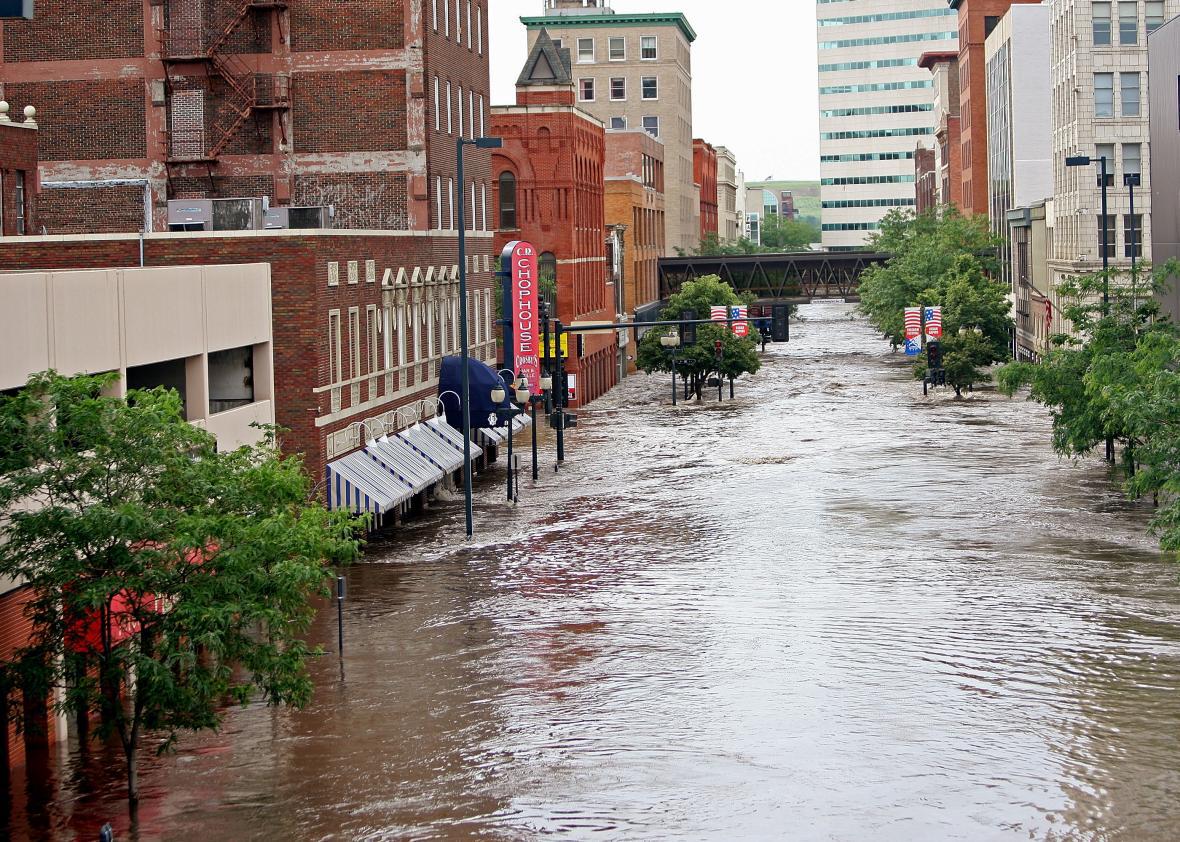That a flood is coming for the American coast is obvious.
But to understand which towns and neighborhoods might be spared the cataclysm, look at two recent disputes between inland communities and the Army Corps of Engineers, which builds flood walls, dunes, levees, and other defenses.
Both Manville, New Jersey, and Cedar Rapids, Iowa, have suffered from river flooding in the past decade. Cedar Rapids experienced its two worst flooding events in recorded history in 2008 and 2016; Manville, which lies at the confluence of the Raritan and Millstone rivers in the suburbs of New York City, flooded in 2007, 2010, and 2011. Both places found this year that they did not qualify for federally funded infrastructure under the Army Corps’ cost-benefit analysis.
Why not? Because the houses aren’t worth much.
We’ve known for a while that wealthy communities are well positioned to respond to climate change. But these two cases illustrate a complicated corollary: The more big or new or expensive buildings you have in a given place, the more likely that place is to qualify for federal flood protection. Neighborhoods with fewer or less valuable structures are left vulnerable by design.
In March, for example, the Army decided not to move forward on flood defenses for the flood-prone Lost Valley section of Manville, about 30 miles southwest of New York, because the benefit-to-cost ratio didn’t get up to 1. The Army studied levees, flood walls, raised streets, dredging, flood-proofing homes, and even buyouts. No project even came close to justifying the costs. The average structure value of Lost Valley’s 250 homes was about $195,000, according to the Corps analysis.
“I know you’re probably not happy to hear this, but we’re bound by the rules,” an Army Corps rep told a meeting of residents.
Town officials say that home values have fallen because of flooding—making it even harder, paradoxically, to justify flood protection. And on it will go. “Because of the Corps’ refusal to act, this has become a self-fulfilling downward spiral that will continue indefinitely,” Manville Mayor Richard Onderko told My Central Jersey.
The Army Corps can generally only approve projects where the benefits outweigh the costs. If so, the project goes forward. If not, you’re on your own.
That’s a good thing. The Army can’t wall in the country’s rivers or sandbag every mile of beach. So it tries to put a dollar figure on the damage that would be avoided by a project’s completion. That figure is based on depreciated structure values.
But because property values in America have diverged so wildly in the past 50 years, Army Corps assessments have internalized and perpetuated capital’s geographical bias. Areas with high property values tend to have higher structure values, fewer empty lots, and more investment.
Often, those biases correspond to economic output, like in Manhattan. Manhattan is also very dense, which makes flood protection more efficient. Dense areas can maintain high structure values, and thus earn Army Corps priority, even if residents aren’t well-off.
But other times, a high concentration of structure values is just a bunch of rich people’s houses. Star Island in Miami’s Biscayne Bay has some of the highest home values in the United States. Gloria Estefan listed her 1.34-acre property there for $40 million last year. Dollar for dollar, that would be a damn good ROI on a sea wall. (Except that no one would pay $40 million to live behind a wall. But I digress.)
It’s an iteration of the larger political debate about subsidies for communities left behind by financial (and intellectual) capital. Usually the question, “Is x worth saving?” is premised on economic development—how much subsidy do we need to keep x or y small-town community ticking?
This time it’s more existential. After Cedar Rapids barely dodged another devastating flood, the city’s flood control program manager told the Des Moines Register that the Army Corps system was “skewed against the Midwest.” Iowa Sens. Chuck Grassley and Joni Ernst wrote a scathing letter to the Army Corps outlining a kind of flood-defense populism.
“As you know, the economic benefits of flood control projects are based on the value of the property that is protected,” the senators wrote. “If this is the only metric used, the Corps and the Administration consider building beaches in front of multi-million dollar oceanfront homes to be a higher priority than protecting the people of Cedar Rapids … it is no longer sufficient to say that your hands are tied and that nothing short of a congressional earmark can help communities like Cedar Rapids that have lower property values.”
How refreshing to see a couple GOP senators question the brutal logic of capitalist valuation! They have asked the Government Accountability Office to complete a study on Army methodologies, in particular the prominence given to structure values. (They might also inquire, perhaps on the Senate floor, into why the city has had its two worst-ever floods in just an eight-year span.)
In Manville, meanwhile, the debate is all but over. Frank Jurewicz, chairman of the Raritan and Millstone Rivers Flood Commission, said the commission had given up hope on the town but hoped to sound a warning to other at-risk communities. “It is simply not fair to penalize Manville residents because their homes are more modest, especially after repeated flooding has cut the value of their homes in half,” he told My Central Jersey.
“There has to be a lot of Manvilles across America.”
